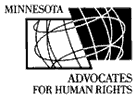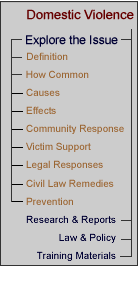|
|
|
COURT MONITORING PROGRAMS Court monitoring programs are programs in which advocates or community members organize themselves to observe court proceedings in a systematic way and to record and make public the results of those observations. Monitoring programs can enhance a community’s response to domestic violence in many ways. Monitoring and documentation can be an important part of judicial reform, lobbying, media relations, and community education campaigns. Objectives of Monitoring WATCH, a U.S.-based court monitoring program in Minneapolis, Minnesota, describes the objectives that guide its efforts to “make the justice system more effective and responsive in handling cases of violence, particularly against women and children, and to create a more informed and involved public.” These objectives are:
Not only does monitoring generate information about aspects of the judicial system that are of concern to battered women, but the presence of monitors in the courtroom can itself help judges and other courtroom personnel become more aware of the way they respond to victim’s needs and the impact they have on batterer accountability. In Why We Watch the Criminal Justice System, WATCH explains that “[a]lthough it is the role of the judicial system to act swiftly, firmly, and consistently to reinforce the message that the violence will not be tolerated, the system frequently fails to do so. . . . The presence of observers in the courtroom can promote accountability and serve as a strong reminder that the public has a vested interest in what happens there.” Starting a Monitoring Program Starting a monitoring program requires considerable preparation to ensure that the program is focused on areas of that are of the greatest concern to battered women and has established cooperative relationships with judges, police, prosecutors, and victim advocates. WATCH, in its publication Developing a Court Monitoring Program, describes the following steps that can be used to prepare a monitoring program: (1) Learn about the criminal justice system: Understand the laws that apply to domestic violence, how cases progress through the system (from the police to probation), and the responsibilities of each actor within the legal system. (2) Determine initial objectives: Establish what the group wants to accomplish and how resources will be directed toward achieving that goal. WATCH recommends defining criteria for selecting cases to watch, and notes that some organizations may want to focus on one particular type of proceeding. (3) Conduct preliminary interviews: Ask members of the criminal justice system about their views on the ways in which (positive and negative) the judicial system responds to domestic violence cases. (4) Assess resources: The scope of the monitoring project will depend on the resources—human and financial—that are available to the organization. (5) Get diversified feedback: Solicit input and participation from all segments of the community. Allowing individuals within the criminal justice system to offer feedback and voice their concerns helps establish a non-adversarial relationship between the monitoring program and the judicial system that will be critical to the sustainability and success of the project. Monitoring There are no definitive rules or formulas for the information that a court monitoring program can collect. The laws, structure of the court system, judicial procedures, and available victim resources will ultimately determine what information will be useful to gather. In general, however, there are two kinds of information that a court monitoring program might collect—process data and substance data. Process data is information about the proceeding itself—i.e., “how” it happened. Did it start on time? Were the defendant and the victim alone in the courtroom at the same time? Could the judge be heard? How did the judge and other courtroom personnel act? Did the judge explain to the victim why and how things would happen? Substance data, in contrast, is information about “what” happened. Was the defendant released? What conditions, if any, were imposed? Was the order for protection issued? Had there been a significant delay since the last appearance? Did the judge give reasons for decisions? Was the victim allowed to make a statement? How monitors gather this information can vary. WATCH, for example, initially gave monitors detailed questionnaires to fill out during each monitoring session. WATCH organizers found, however, that they could not anticipate every issue that might be of relevance to a later analysis. To generate better information, WATCH expanded the training it provided to monitors and allowed monitors more freedom to record data that they thought was relevant to victim safety and batterer accountability. Monitors are still asked specific questions about procedure and substance, but are also allowed ample space to describe the process and substance of the proceeding in their own words. Data Collection Monitoring groups also may want to track certain cases or defendants. Tracking helps monitors to describe the judicial system’s response to domestic abuse cases over time and can be particularly useful in identifying systemic failures. For example, tracking a defendant or case over time can provide powerful evidence of whether the criminal justice system is consistently holding batterers accountable for their actions. Tracking may also reveal, for example, that judges are not receiving the information they may need to make informed decisions about victim safety. Working with the Judiciary Information gathered through monitoring activities can be used to advocate for change and raise public awareness about domestic violence. WATCH, for example, focuses its efforts on four groups: judicial personnel, the legislature, the public, and the media. Lobbying, community education and media relations are strategies employed by many domestic violence advocates. Establishing and maintaining effective relationships with judicial personnel, however, is of particular concern to monitoring programs because of these programs are located in and work within the court system. WATCH emphasizes the importance of maintaining open lines of communication with judicial personnel and recommends the following guidelines:
From WATCH, Developing a Court Monitoring Program 130. It may also be useful to allow judges who are monitored the opportunity to review findings and clarify inconsistencies—though without giving the judges veto power over the content of the report. From Honorable Judge Ron Adrine, A View From the Bench 2 (2001). |

